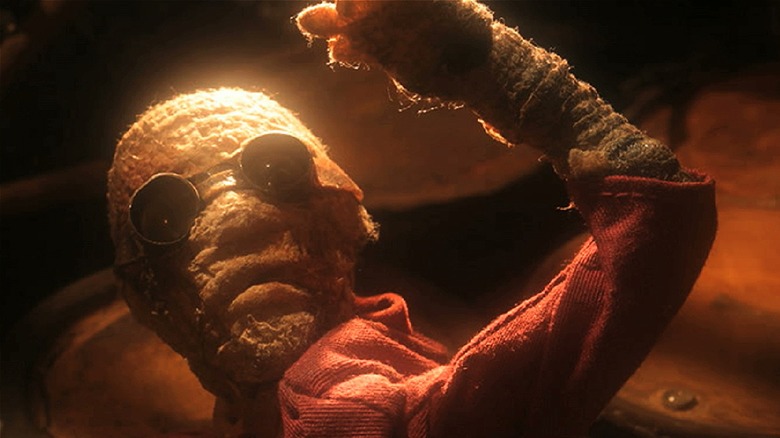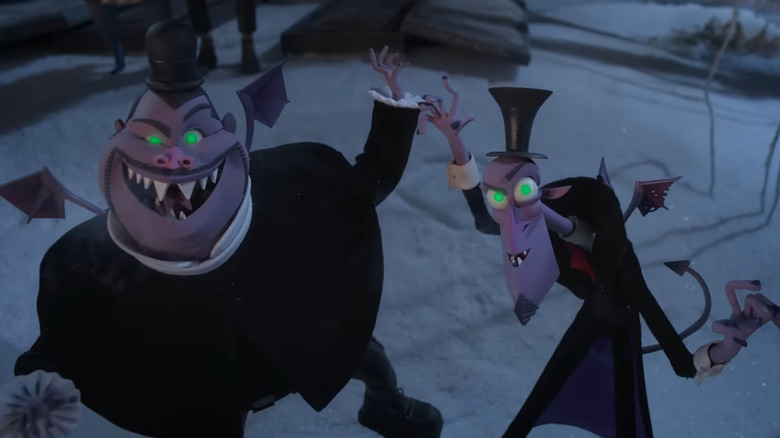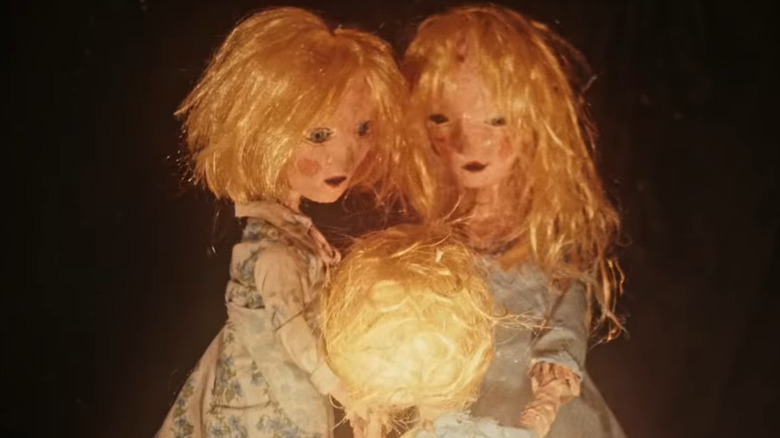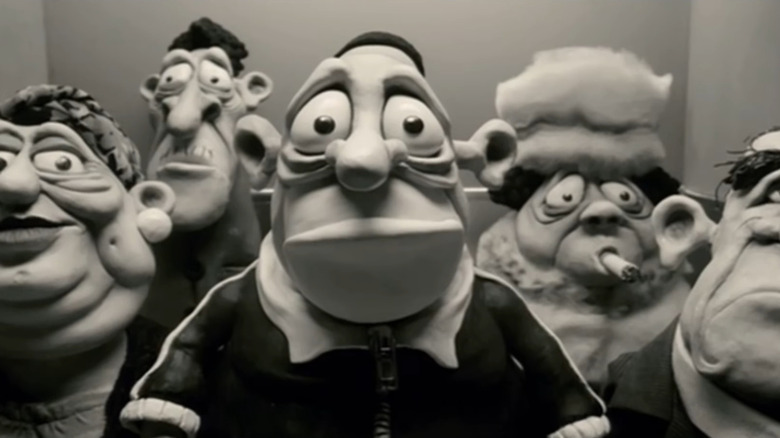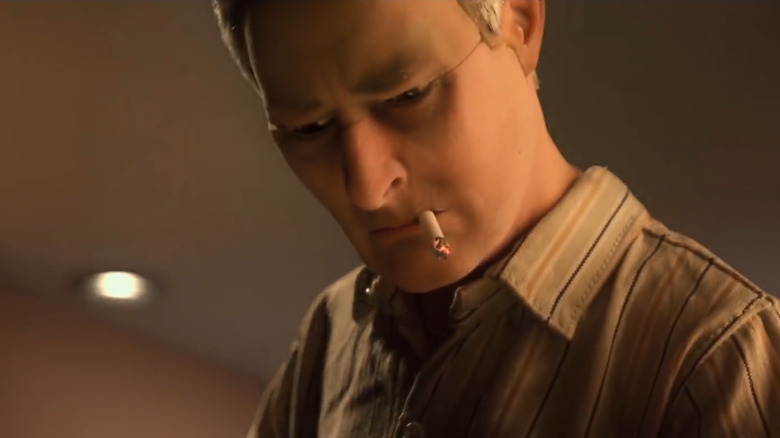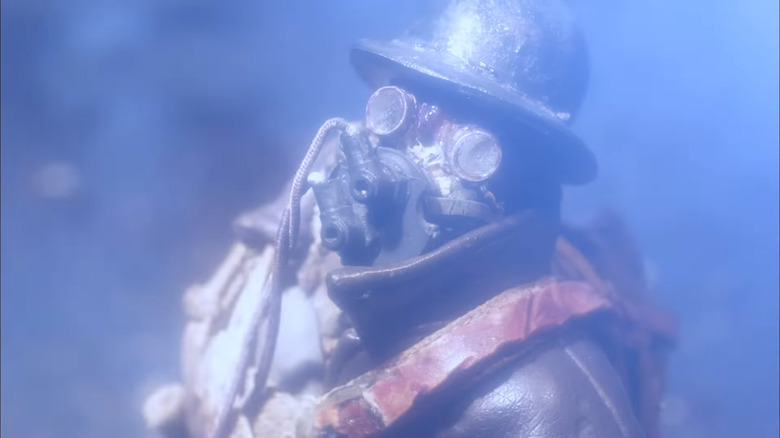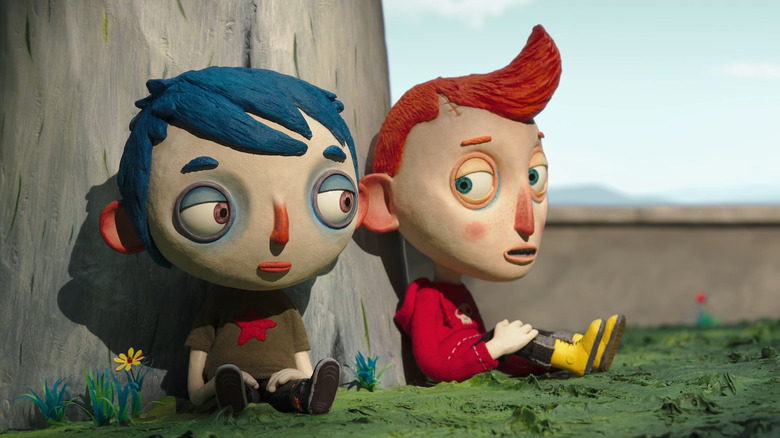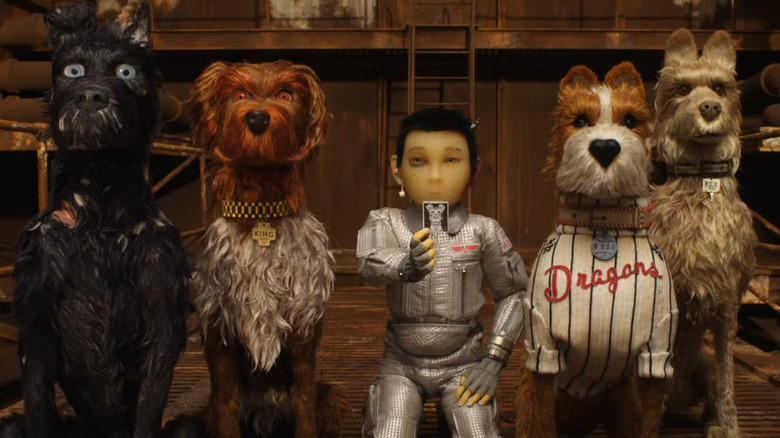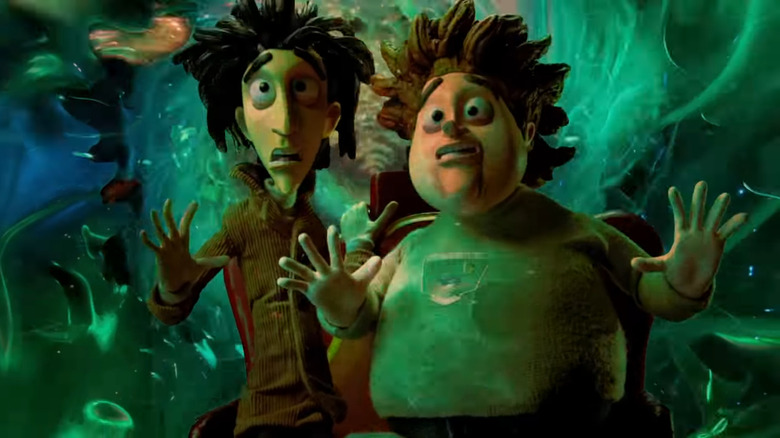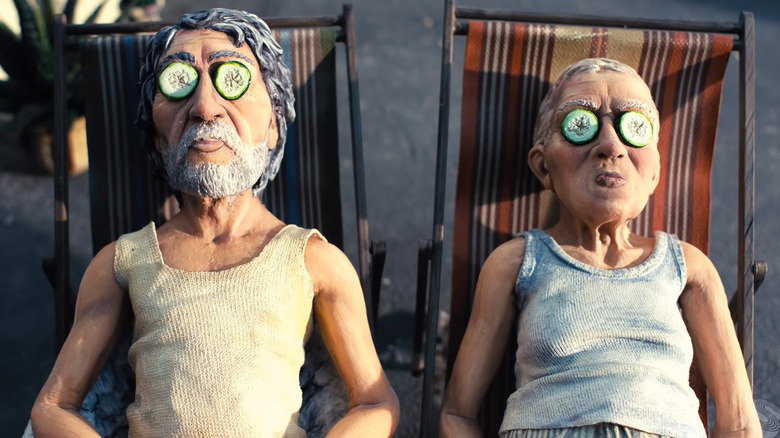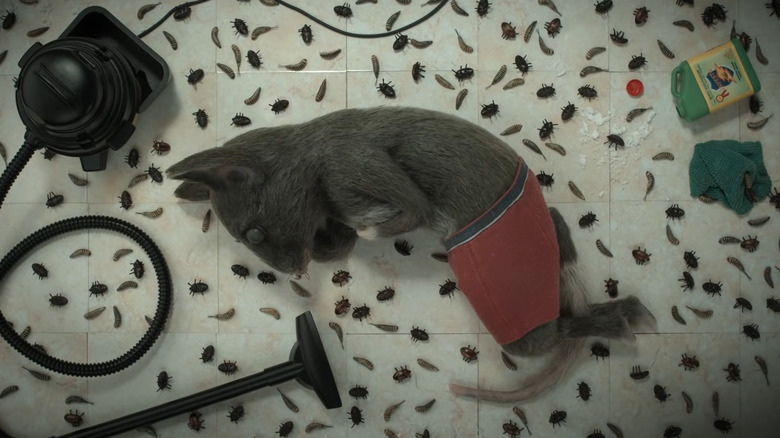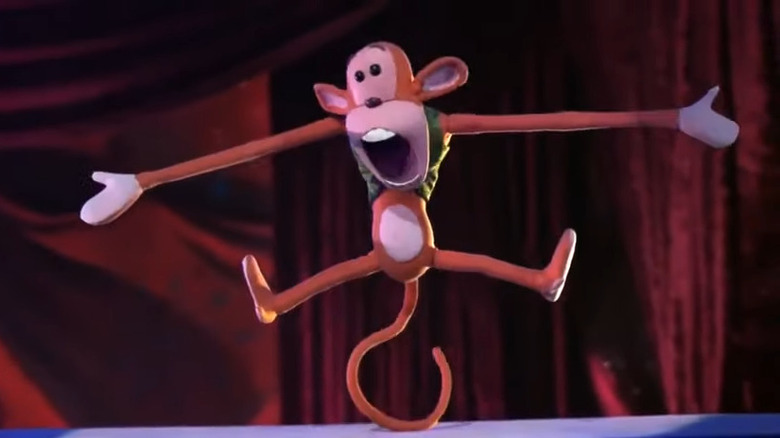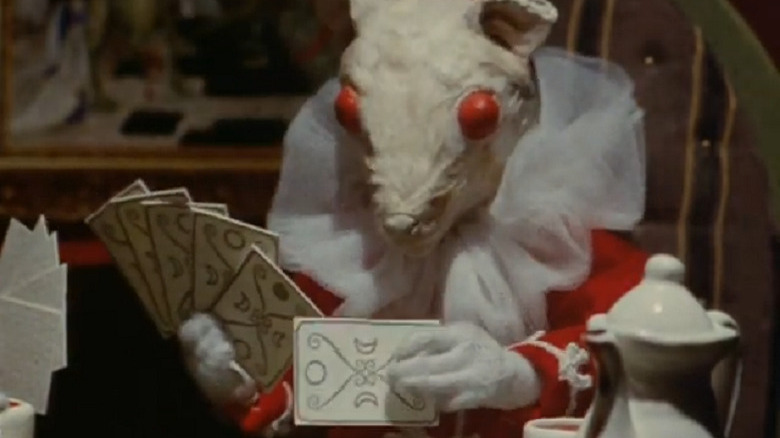12 Stop-Motion Movies Made For Adults
In an interview at the red carpet premiere of his stop-motion adaptation of "Pinocchio," Guillermo del Toro made the following comment: "We wanted to show that animation is not a genre for kids, it's a medium. Animation is film. Animation is art. And it can tell stories that are gorgeous and complex" (via Discussing Film). While his version of "Pinocchio" — which takes the classic children's story and restages it to be set during the rise of Mussolini in fascist Italy — may be a perfect example of the kind of beautifully-constructed nightmare fuel that del Toro excels at, the truth is that the medium has been telling stories aimed at an older audience for many years now.
Perhaps more so than any other form of animation, stop-motion possesses a tactile quality that can be pushed to create feelings of warmth and repulsion in equal measure. For a certain breed of filmmaker — equipped to push what the medium is capable of — stop-motion can be effectively used to examine all sorts of human issues. While this often results in films that fail to make their money at the box office — and are best avoided by the younger audience that most animation tends to cater to — it also results in the kind of breathtakingly impressive works of art like the ones listed here. With plenty of variety and imagination between them, these are some of the best stop-motion animations made for adult audiences.
1. Wendell & Wild
Anyone who knows anything about stop-motion animation will likely recognize the name, Henry Selick. The director rarely gets enough credit for his directing duties on "The Nightmare Before Christmas" — a film that is frequently attributed to producer and story creator Tim Burton, much to Selick's chagrin (via The A.V. Club). But Selick is arguably one of the most talented and creative filmmakers to regularly work in the medium — based on his work on films such as "James and the Giant Peach" and "Coraline." After a 13-year hiatus, the director finally returned with the 2022 Netflix venture "Wendell & Wild," which teams him up with producer and co-writer Jordan Peele to craft a new story that's every bit as spooky as it is entertaining.
Though the younger protagonist and colorful depictions of ghosts and demons might lead one to believe that this is a film aimed at the same demographic that devoured Selick's previous films, his latest outing actually has a lot on its mind that will likely go over the heads of most younger viewers. The kind of socio-political commentary that Peele brought to his own films is certainly evident here, and the film devotes much of its runtime to criticizing for-profit prison systems and the ways in which they can ruin a town where they're located. Combined with a number of surprisingly brutal death scenes, you have a PG-13 experience that's best reserved for a slightly more mature audience.
2. The Wolf House
The majority of American readers may not be very familiar with this deeply experimental fairy tale — known in its native Chile as "La Casa Lobo." But anyone who has any enthusiasm for the craft of animation should absolutely check it out because the techniques used to bring this story to life are completely unlike anything you'll have seen. On the surface, the plot is relatively simple. It follows a young woman named María (voiced by Amalia Kassai) who has escaped from a German colony and takes refuge in a seemingly abandoned house occupied by two pigs, whom she adopts and attempts to humanize.
This setup might already seem a little much for kids, but that's before we get into how the story is told. Constructed to feel like one continuous shot, the characters and environments are assembled and animated in real-time using a variety of stop-motion elements that include paint, papier-mâché, elaborate puppets, and much more. The resulting concoction plays like a grim folk tale that's brought to life with a sense of wonder as well as some deeply unsettling imagery. There's also the matter of the wolf character, who stalks through the periphery of the film menacing the protagonist in voiceover, bringing a shroud of darkness whenever his presence nears. This puts "The Wolf House" into downright horror territory, with the kind of visuals that can easily give children nightmares.
3. Mary and Max
Even in live-action, the kinds of films that are willing to deal honestly with subjects like depression, social anxieties, and mental illness are few and far between. This is what makes a film like "Mary and Max" such a breath of fresh air — despite its aesthetic being dominated by a grayed-out color palette. The story follows a pen-pal correspondence that spans two decades across two completely different countries, between two people who find common ground through their unique eccentricities and worldview.
Toni Collette provides the voice of Mary, a lonely little girl from the Australian suburbs who one day decides to pick a name out of a phone book and write them a letter. The recipient is a New York City resident with Asperger's syndrome named Max, voiced by the late Philip Seymour Hoffman. Through their extended written back and forth, each of them undergoes numerous life changes, including romantic entanglements, finding their dream jobs, and taking care of their bodies, all while serving as a consistent voice of support and perspective in each others' lives. Though Mary is initially 8-years-old when we meet her, that shouldn't be used as a metric to show this film to kids in her age range, as the deeper themes about aging and finding connection in an otherwise dreary world will likely play far better to a more grown-up audience.
If you or someone you know needs help with mental health, please contact the Crisis Text Line by texting HOME to 741741, call the National Alliance on Mental Illness helpline at 1-800-950-NAMI (6264), or visit the National Institute of Mental Health website.
4. Anomalisa
Few filmmakers can lay claim to the kind of bold eccentricity that Charlie Kaufman exhibits on a regular basis. The Oscar-winning writer and director — who has worked on such mind-boggling classics as "Being John Malkovich" and "Eternal Sunshine of the Spotless Mind" — turned his attention to stop-motion with 2015's "Anomalisa." Co-directed with Duke Johnson, the film is characteristic of Kaufman's work in that it is predominantly focused on the interior life of a man who struggles to connect with other people. The man in question here is Michael Stone (voiced by David Thewlis), a motivational speaker who has become so detached from the mundanity of modern life that he hears every other person — regardless of gender — speaking in the monotone voice of the character actor, Tom Noonan.
All of this is upended one fateful night when he meets Lisa (Jennifer Jason Leigh), whose seemingly ordinary nature strikes Michael as extraordinary. They spend an extended evening getting to know each other intellectually, before getting to know each other physically. The graphic depictions of puppet intercourse would normally be more than enough to regard this film as not being intended for children, but the existential despair and distinctively middle-aged concerns present in the rest of the film would likely hold little interest for young ones either, rendering this film a strictly adults-only affair.
5. Mad God
We've come a long way from the days of movies like "Jason and the Argonauts" and "Beetlejuice," where stop-motion elements could coexist alongside live-action film to create imagery that dazzled audiences for decades. With the CGI boom of the '90s, however, hand-animated special effects quickly began to give way to computer-generated ones (via Empire). Of the many artists who had invested their livelihood into the craft and were now negatively impacted by this changing of the guard, one of the most prominent was Phil Tippet. A stop-motion master, who had worked on films such as "Jurassic Park" and the original "Star Wars" trilogy, Tippet's skill was renowned, yet not enough to prevent the incoming tide of digital filmmaking that would threaten to make him obsolete.
Rather than sit on his laurels, Tippet turned his attention to a personal project: "Mad God," an independently produced passion project that would ultimately take him 30 years to complete (via Variety). The results are jaw-dropping, with a very loose story about a series of miners traversing through a dystopian hellscape with all manner of bizarre creatures, elaborate machinery, and some creations that blur the line between the two. The creativity on display is dazzling, with a true sense that anything could happen from one minute to the next. However, that creative imagery also contains lots of nudity, graphic violence, and scatological elements that most parents will probably prefer not to expose their children to.
6. My Life as a Zucchini
Anyone who only looks as far as the adorable character designs in "My Life as a Zucchini" would be forgiven for assuming that the film features a bunch of cutesy kids getting into a bunch of kid-friendly adventures. And while that's broadly true to a certain extent, this PG-13 drama is not exactly as innocent as it looks. Taking the frequently used animation trope of child protagonists having only one or none of their parents, the film explores this concept in a way that's both deeper and more realistic. The titular Zucchini (nicknamed as such by his alcoholic mother who suddenly disappears one day) joins a group of fellow kids at an orphanage and finds himself making significant friendships that help him better understand himself and his situation.
The film comes from an impressive pedigree — having been written by "Portrait of a Lady on Fire" director Céline Sciamma — and earned enough praise to warrant an Oscar nomination for best animated feature of 2016. A frequent source of acclaim was its earnest and mature handling of topics that are frequently considered taboo, such as the trauma that abusive or neglectful parents can inflict on children, and how that shapes their ability to make friends and understand their place in the world. Teenagers should be able to appreciate it, but anyone younger may not fully grasp it yet.
If you or someone you know may be the victim of child abuse, please contact the Childhelp National Child Abuse Hotline at 1-800-4-A-Child (1-800-422-4453) or contact their live chat services.
7. Isle of Dogs
It's hard to imagine another director — who primarily works in live-action — with sensibilities that translate so perfectly to animation quite like Wes Anderson. The quirky filmmaker, best known for his diorama-esque compositions and colorful characters made his first jump to stop-motion with a more family-friendly affair — the 2009 adaptation of the classic Roald Dahl story, "Fantastic Mr. Fox." While that film was mature in its emotional dynamics and featured plenty of knowing references for adult viewers, it was still mostly accessible to younger viewers. His next foray into animation almost a decade later was 2018's "Isle of Dogs," which featured plenty of cute characters but a far more intricate plot.
A viral pandemic known as the dog flu ravages the fictional Japanese city of Megasaki, leading its authoritarian and corrupt mayor to issue a decree that all dogs must be banished to the nearby Trash Island. Much of the story deals with a young boy who seeks to reunite with his exiled best friend, assisted by a band of adorably fluffy canines voiced by beloved character actors including Bryan Cranston, Bill Murray, and Jeff Goldblum. Even with these superficially cute elements, the film still feels more adult-focused with its snarky brand of humor and its treatise against government corruption — which feels even more relevant now that we've had an actual pandemic since its release.
8. Hell and Back
Sometimes you can tell that a film is intended for more adult audiences through its themes, its subtext, or its more mature subject matter — dealing with topics most children will not be able to fully understand or appreciate. Other times, you can tell they're made for an older crowd because it contains "pervasive strong crude and sexual content, language and some drug use" (via Rotten Tomatoes). This certainly applies to 2015's "Hell and Back," a raunchy buddy comedy about a trio of best friends and carnival workers voiced by Nick Swardson, T.J. Miller, and Rob Riggle. When they jokingly take — and subsequently break — a blood oath, one of the three finds themselves getting sucked into Hell, with the pair left behind embarking on a quest to rescue him.
This is not a film that has much use for subtlety, and as such figuring out why it's not child-friendly is not a difficult task. The film's dialogue is laden wall-to-wall with the kind of edgy and offensive humor that would make "South Park" proud, with plenty of references to intimate acts and organs. Even the Devil himself (voiced by Bob Odenkirk) gets in on it, trading immature barbs with the rest of the stacked cast which also includes Mila Kunis and Susan Sarandon. Nobody will ever mistake "Hell and Back" for high art, but it has its audience — it's just not advisable for kids to be part of that audience.
9. $9.99
Based on a series of short stories by Israeli writer Etgar Keret, this Australian slice of stop-motion is one of many that uses the form to create a believable story about normal people living their lives as opposed to anything fantastical. The closest thing that "$9.99" has to an extraordinary element is an angel character voiced by Geoffrey Rush, and even he is a mostly innocuous presence, serving as a positive influence but mostly minding his business on the sidelines. As befitting its short story origins, the film focuses on an ensemble of disparate characters living in a Sydney apartment complex, all of whom are looking to find meaning in their lives.
These individuals run the gamut from a soccer-obsessed young boy, an isolated old widower, and a stoner hallucinating that he has several tiny friends, voiced by an impressive ensemble of Australian talent including Anthony LaPaglia, Ben Mendelsohn, and Joel Edgerton. Beyond the fact that most kids would probably find the stories of normal people living their normal lives to be less than exciting, the fact that those people are dealing with such themes as finding purpose, society's lack of communication, crushing loneliness, and drug addiction should be more than enough to discourage any younger audiences that the film might have had.
If you or anyone you know needs help with addiction issues, help is available. Visit the Substance Abuse and Mental Health Services Administration website or contact SAMHSA's National Helpline at 1-800-662-HELP (4357).
10. The House
One storytelling device that stop-motion animation — or for that matter, any form of animation — can excel at is the anthology. If you take a series of loosely connected narratives and give each one a unique visual identity, you have a piece of film that really showcases what the medium can do. A great example of this comes in 2022's "The House," which serves up three tales that all revolve around the titular abode. The first sees a family of humans take up residence in the house, only for the parents to become so obsessed with it that they start to become one with it. The second sees a mouse (voiced by Jarvis Cocker) attempt to renovate the house before it becomes infested with bugs, and eventually with bug-like mice.
These first two segments are certainly not child-friendly, as they utilize the inherent unreality of felt puppets behaving like people to create an atmosphere of dread and inevitability, with some body horror elements that will likely be too frightening for impressionable viewers. The third segment, which focuses on a cat (voiced by Susan Wokoma) attempting to return the house to its former glory while the world outside it has disappeared under a mass flood, is perhaps the most gentle of the lot. That said, it does still deal with existential crises about how we cope with the world coming to an end around us, which may prove to be a bit too heavy for young ones to enjoy.
11. Monkeybone
Some might contest the inclusion of this 2001 fantasy comedy considering that much of it is rendered in live-action. However, stop-motion animation does play a crucial role throughout, and the involvement of director Henry Selick makes it worth a watch. "Monkeybone" gets its title from the name of a randy cartoon chimp created by Stu Miley (Brendan Fraser), who is celebrating his comic strip being turned into a TV series and preparing to propose to his girlfriend Julie (Bridget Fonda) when a freak accident lands him in a coma.
Rather than simply lapsing into unconsciousness, Stu's mind is transported to a carnivalesque world known as Downtown, which represents a sort of limbo between life and death. It is populated by a variety of colorful characters, including none other than Stu's own creation, Monkeybone (voiced by John Turturro). Complicating our protagonist's hopes of awakening from his coma — before his sister (Megan Mullally) pulls the plug — is the fact that Monkeybone has designs on hijacking his body, which leads to all sorts of crazy antics. Though the film may appear to have a playful, slapstick quality that would normally make it a perfect fit for kids, its humor tends to run both darker and lewder than most parents would likely be comfortable with, and many of the more surrealist depictions of its fantasy world quickly take on a more nightmarish quality.
12. Blood Tea and Red String
Described as a handmade stop-motion fairy tale for adults, this micro-budget independent feature was almost exclusively animated by director Christiane Cegavske over the course of 13 years (via Fangoria). The love and attention to detail really show as it tells a dialogue-free story about a conflict that brews between a group of wealthy and noble white mice, and the peasant creatures who dwell under an oak tree. The mice hire the creatures to craft a beautiful doll for them — with the red string being used as the adorning touch. When the creatures find that they love their creation too much to give it up, the mice decide to steal it for themselves.
The plot is hardly the point here, as much of the film is focused either on the oak dwellers journeying through the fantastical world that Cegavaske has created or on seeing the mice gradually succumb to the corrupting influence of the blood tea. It's all about the experience, which is heightened by an oppressive, unsettling soundscape and the escalating threat of debauchery and violence against the characters. Despite some initially peaceful imagery that looks like it might be right at home in a child's fairy tale, "Blood Tea and Red String" creates a haunting atmosphere that is far less likely to delight young viewers and far more likely to send them home with nightmares.
